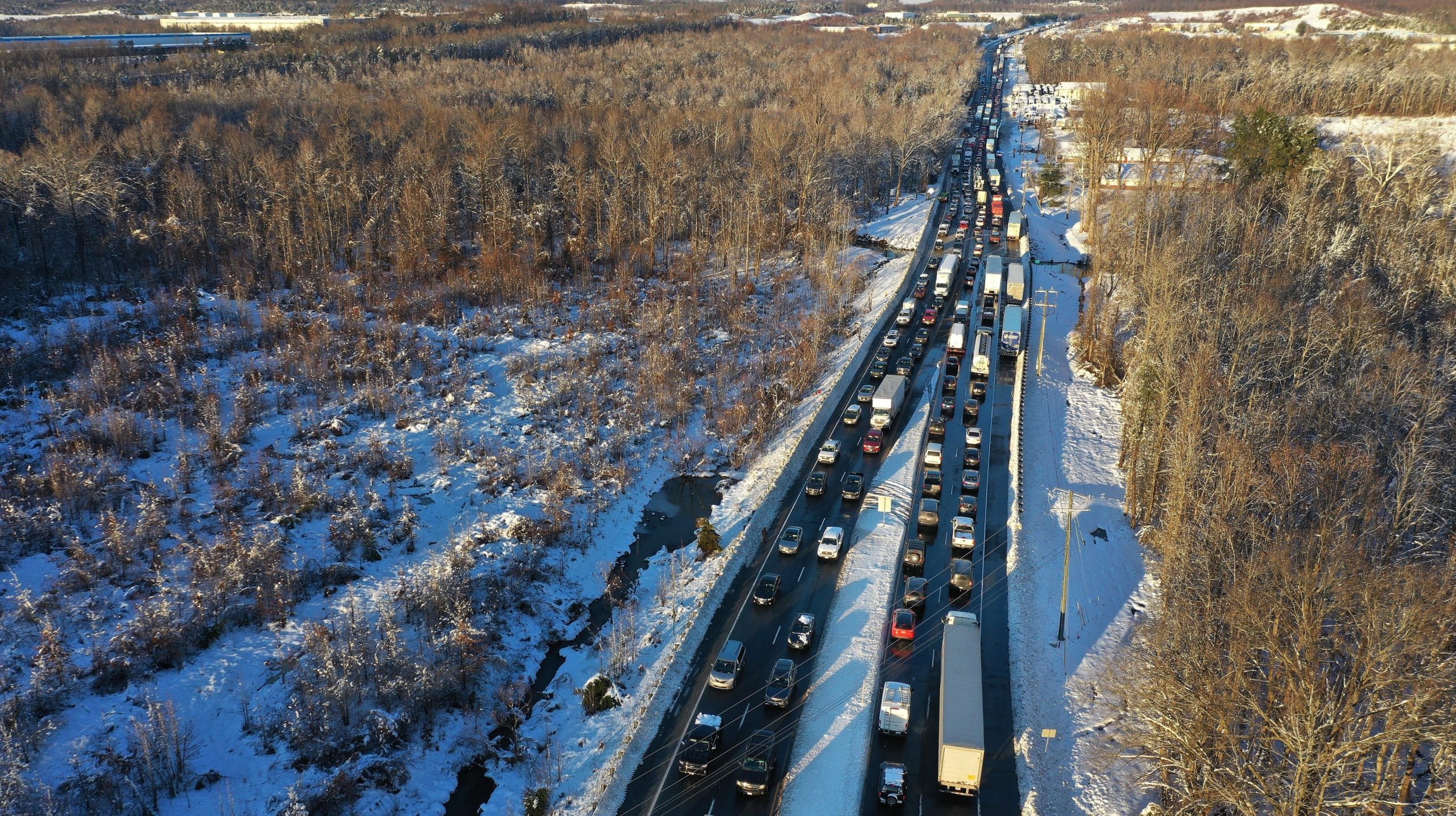
We reached Falmouth near Fredericksburg shortly before nightfall—by which time hundreds of people had been stuck on stretches of I-95 in our path for most of the day. Waze, clearly under the impression it was far more clever than it really was, tried to get us around a blockage by taking some side roads (Maps suggested similar routes). The only problem was that these side roads were unplowed, covered in snow and ice, and quickly being flooded by hundreds of other drivers whose GPSes had clearly come up with the same idea. This is when we got trapped for the first time: We neglected to go down a particularly alarming road suggested by Waze, but while trying to pass a car on another unplowed street, our right tires got stuck in a snowbank. A good Samaritan living nearby helpfully came out with shovels, but the road was packed with other cars getting stuck, including a van we had to help dig out first. By the time we finally got out of there, over two hours had passed.
Advertisement
Shortly before we left, the good Samaritan mentioned that apps must have been to blame for the situation unfolding off his driveway, because it had been quiet all day until an avalanche of cars suddenly arrived.
Waze got us moving north on Route 1 for a while, but yet again advised us to get on I-95. This was a disastrous lapse of judgement, though perhaps inevitable at this point, as Waze had successfully led us into a trap with no other way out. More importantly, its estimated delay time fluctuated as low as a few hours. This was pure bullshit. After getting on I-95 sometime around 7:00 p.m., we were greeted on I-95 by a sheen of black ice and trapped cars stretching forward as far as we could see. Waze took the opportunity to start giving us more honest delay estimates, like three and a half hours to get less than 10 miles north to a hotel.
Advertisement
When you’ve been stuck unmoving on black ice for hours, periodically firing up the engine to get the front seats above freezing before turning it back off to save gas, some weird thoughts might enter your mind. Completely illogical, conspiratorial thoughts like, “Hey, maybe getting me stuck here, endlessly refreshing Waze and looking for hotels on Google Maps, was what Google wanted the whole time.” It was at least a change of mental dialogue from prior questions like, “Has Virginia ever heard of goddamn salt” or “Will the state troopers arrest me for peeing on the side of the road?”
With the hindsight of the Washington Post’s timeline of the I-95 fiasco, certain things make more sense. The inconsistent estimates offered up by Waze and Google Maps were likely somewhat related to VDOT’s slow timeline on acknowledging how bad the situation was; it didn’t admit a “complete blockage” of traffic until midnight, after drivers had been trapped for hours. For some reason that evades all logic, I-95 wasn’t officially shut down until three hours after that. Presumably, Google Maps and Waze kept on recommending I-95 as an actionable route until then.
Advertisement
“During unpredictable conditions, our team works as quickly as possible to update routes using details from local authorities, feedback from drivers, and sudden changes to driving trends,” a Google spokesperson told Gizmodo via email. “Earlier this week, we displayed a winter storm warning and stopped routing through I-95 once we verified that it was closed. We encourage everyone to stay alert and attentive, especially when driving in bad weather.”
More importantly, Google Maps and Waze aren’t like plain old paper maps of old. When you use a paper map, the active actor is you. You have to chart the route. No one ever blames an accurate paper map for getting them lost. But by their very design, navigational apps afford users the comfortable illusion of blurring who exactly is in charge. They will always attempt to chart you a route, no matter how ill-advised seeking a route in the first place may be, and they will dutifully march you along it Lemmings-style, if you let it. Outside of truly extreme situations like wildfires or terror attacks, they will never tell you that hey, maybe it’s a better idea not to drive at all.
Advertisement
Of course, we were the ones in control. At any point, we could have just cut our losses and… stopped. Found a hotel or something. Instead, we let some algorithm keep pushing us onwards and onwards, heedless of the consequences until it was too late. That thousands of other people clearly did the same thing is cold comfort.
Anyhow, there’s clearly a lesson to be learned here of some kind. If anyone knows what app I can download to figure that out, let me know.
Advertisement
